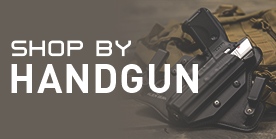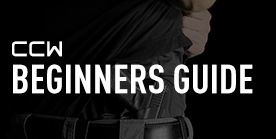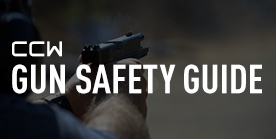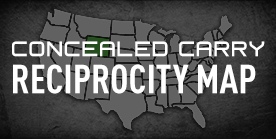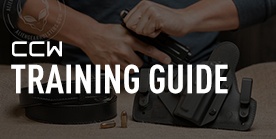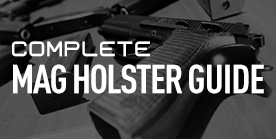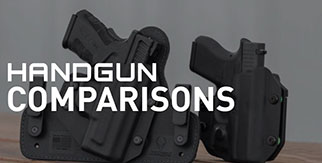Do You Need An FBI Cant Holster?
You might have heard the phrase FBI cant holster and wondered what the heck that is. Some even insist it's required for concealed carry.
The FBI cant is a colloquial term to refer to a concealed carry holster that has a moderate forward tilt. The word "cant" has multiple meanings, among them a slope to one side.
A canted holster became associated with the FBI over the years, and has thus entered the gun/concealed carry lexicon. If you carry in a typical strong-side concealed carry holster, it's actually a good thing to have, but nothing to worry about if you don't.
Origins Of The "FBI Cant Holster"

The genesis of the "FBI cant holster" requires one to reach back into the fabled mists of time.
So, for a bit of holster history:
Up until the late 50's/early 60's, the dominant duty holster design was the Threepersons' Holster, a hip holster with an exposed trigger guard and usually a simple hammer loop for retention. Eventually, holster makers added a snap and strap.
There were a few other designs that emerged, including what came to be called the "Jordan holster." The Jordan holster was devised by Bill Jordan, the legendary Border Patrol agent, exhibition shooter and Marine Corps veteran. Jordan improved the Threepersons design by adding a steel shank to the body, a snap loop that fastened to the holster body, and canting the holster forward.
Jordan recommended officers carry a holster with a slight forward lean, and a gun with a barrel no longer than 4 inches, with the reason being that the cant angle and shorter barrel wouldn't jam into the seat of a patrol car.
What the heck does any of this have to do with the "FBI cant holster" stuff? I'm almost there.
The Bureau didn't really have a standard equipment list until far longer into its history than you might think! Even in the post-war period, agents had to cobble together what they could; there wasn't even a standard FBI duty gun until the 70s, the Smith and Wesson Model 10.
Popular holsters included Jordan rigs (told you I was getting there) as well as Bianchi thumb-break holsters (which closed the trigger guard and added the Bianchi thumb break) and Berns Martin holsters, an open-top OWB with a split front that allowed the user to break the gun out of the front of the holster rather than draw out of the top.
Now what this means is that FBI agents were known for carrying a holster with a forward cant rather than a straight drop. Such a holster allowed the user to wear the holster in a vehicle or sit down at their desk without discomfort. When carrying a compact pistol in a high ride OWB holster, it's also easier to conceal the pistol under a coat.
FBI agents usually work in plainclothes, so these features are naturally advantageous. Since they are a little different than the typical police holster, and typical civilian carry holsters of the era were also commonly a straight-drop, the association with FBI agents was made.
What IS The FBI Cant?
The FBI cant really is just a moderate tilt forward. The exact measurement is a matter of some discussion; while it might be the classically-quoted measurement the truth is the exact degree of cant doesn't matter in the real world. The effects are the same in any case.
It's commonly believed that the FBI cant is a 15-degree forward tilt. Granted, the exact figure varies, depending on whom you ask. Some insist it's up to 22.5 degrees, I've found some people saying its 12.5 or 13 degrees, and so on.
What we can infer, however, is that an FBI cant holster has a positive cant of 15 to 25 degrees.
A holster with a cant of that angle will have all the benefits that the high-ride OWB holsters that agents started wearing back in the day. If the degree of cant is a few degrees more than the fabled 15 degrees, it's not going to make that much of a difference; what does matter is that it's more than 10 degrees but less than 30 degrees.
It's not as if these things are maintained by Weights and Measures, people.
Should I Get An FBI Cant Holster

Unless you appendix carry or don't carry on the waistband, an FBI cant holster is actually a really good idea.
Unless you find a straight drop is more to your liking of course; it's really all about what works best for you.
In fact, that's why most IWB holsters these days either come from the factory with a cant to the holster shell.
All the advantages that FBI agents - it should be pointed out that PLENTY of detectives and plainclothes police officers nationwide all wore the same gear as the FBI - noticed about a slight tilt to the holster are still present. It's more comfortable to sit down with. The barrel isn't jammed into the base of a car seat or desk chair. Access while sitting is made a little easier, though it isn't always the easiest to get to your gun when seated.
Additionally, concealment is made a little easier, as the grip of the gun isn't thrust straight into your clothing, which reduces printing.
Bear in mind, however, that this basically applies to people who are carrying an IWB holster on the strong side, usually between the 3 o'clock to 5:30 position. People who carry in the appendix position or with different holster styles aren't going to get any benefit out of it.



